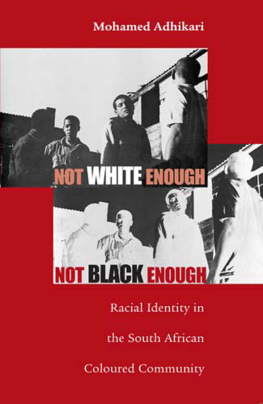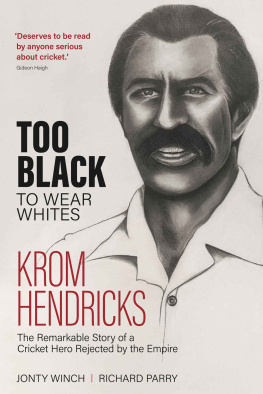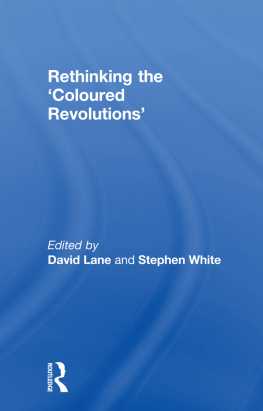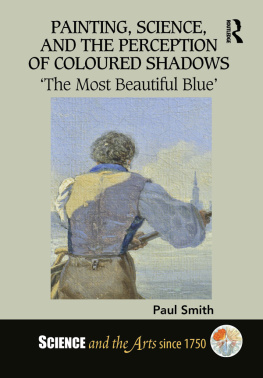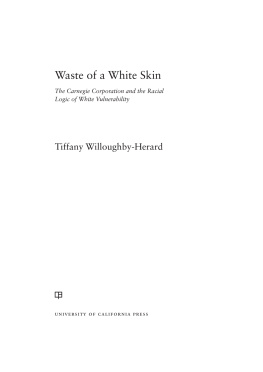Contents
Page List

Not White Enough, Not Black Enough
This series of publications on Africa, Latin America, Southeast Asia, and Global and Comparative Studies is designed to present significant research, translation, and opinion to area specialists and to a wide community of persons interested in world affairs. The editor seeks manuscripts of quality on any subject and can usually make a decision regarding publication within three months of receipt of the original work. Production methods generally permit a work to appear within one year of acceptance. The editor works closely with authors to produce a high-quality book. The series appears in a paperback format and is distributed worldwide. For more information, contact the executive editor at Ohio University Press, The Ridges, 19 Circle Drive, Athens, Ohio 45701.
Executive editor: Gillian Berchowitz
AREA CONSULTANTS
Africa: Diane M. Ciekawy
Latin America: Thomas Walker
Southeast Asia: William H. Frederick
Global and Comparative Studies: Ann R. Tickamyer
The Ohio University Research in International Studies series is published for the Center for International Studies by Ohio University Press. The views expressed in individual volumes are those of the authors and should not be considered to represent the policies or beliefs of the Center for International Studies, Ohio University Press, or Ohio University.
Not White Enough, Not Black Enough
RACIAL IDENTITY IN THE SOUTH AFRICAN COLOURED COMMUNITY
Mohamed Adhikari
Ohio University Research in International Studies
Africa Series No. 83
Ohio University Press
Athens
Double Storey Books
Cape Town
2005 by the
Center for International Studies
Ohio University
Printed in the United States of America
All rights reserved. No part of this book may be reproduced or utilized in any form and by any means, electronic or mechanical, including photocopying, without permission in writing from the publisher.
14 13 12 11 10 09 08 07 06 05 5 4 3 2 1
The books in the Ohio University Research in International Studies Series are printed on acid-free paper 
Published 2006 in Southern Africa by Double Storey Books,
a division of Juta & Co. Ltd, Mercury Crescent, Wetton, Cape Town, South Africa
ISBN 1 77013 002 0 (Double Storey)
Library of Congress Cataloging-in-Publication Data
For Rafiq and Zaheer
Contents
Acknowledgments
The long-germinating seed for this book and, more generally, my interest in the nature of Coloured identity was planted sometime in March or April 1979 when, as a second-year history student at the University of Cape Town, I went on one of my periodic visits to Marie Mauds office. Marie was a lecturer in the History Department, a colorful if somewhat eccentric figure. She was an inspired teacher who took a personal interest in her students and befriended many of them. Her office served as a congregating point for students where one could engage in discussion over a wide range of topics, particularly issues relating to contemporary politics in South Africa, over a cup of tea and a cigarette. By this time Marie had become a firm friend and a mentor despite my Non-European Unity Movement background teaching me to despise weak-kneed liberals. Marie might have been a self-proclaimed liberal but was not weak-kneed and did more than her share to undermine the apartheid system. On that late-afternoon excursion I encountered a forty-something first-year history student I had known for some weeks, in her office. He was a school principal from the tiny, conservative, northern Cape town of Keimoes who had taken a years leave to complete his Bachelor of Arts degree at UCT. With his very fair skin and red hair he was obvioiusly white. After chatting for a while the principal from Keimoes left, whereupon Marie, in characteristically melodramatic fashion, said, Mohamed, I feel so sorry for that poor man! Immediately there flashed through my mind images of him being diagnosed with a dreaded disease, being informed that his wife had suddenly died or that one of his children had been run over by a bus. Upon inquiring what the matter was, Marie replied, That poor man is Coloured. Can you imagine what it must be like for him living in Keimoes? Marie had inadvertently provided future direction to my research, for in subsequent years, pondering the vagaries of life for a pale-skinned, red-haired, Coloured person in conservative Keimoes played an important part in my choice of research topics as a postgraduate student.
I would like to thank Richard Mendelsohn for his unflagging support, his wise counsel, and his incisive reading, as supervisor, of the doctoral thesis on which this book is based. On numerous occasions, I have drawn on the specialist knowledge of colleagues, and I have a memory of pestering Chris Saunders, Bill Nasson, Neville Alexander, and Satyendra Peerthum with esoteric questions. To these and others who have been willing to help, I am grateful. Special thanks are due to Robin Kayser and Shaheen Ariefdien for sharing with me their source material and research findings. I would also like to thank Colleen Petersen for her efficient and congenial help with a range of tasks. I am particularly indebted to her for being prepared to sacrifice time over a weekend to help me recover from a computer-related mishap. Many people, too numerous to mention here, have provided support and encouragement over the years. They have my undying gratitude. The efficient and courteous service of staff members at the African Studies Library at the University of Cape Town and the Cape Town branch of the National Library of South Africa is also greatly appreciated. I would, in addition, like to acknowledge research funding over several years from the University of Cape Towns University Research Committee. Funding from the National Research Foundation also helped ease the financial burden. Finally, the love and warmth of my sons, Rafiq and Zaheer, and a host of dear friendsincluding Shadow, Peggy, Ratso, Prince, Lady, Edgar, Oscar, and Junior (and hopefully Skipper will do his bit in the future)have made the very rewarding task of producing this manuscript all the more enjoyable.
Introduction
The nature of Coloured identity, its history, and the implications it holds for South African society have evoked considerable interest in recent times. Debates around these issues have generated much controversy, yet there has been no systematic study of Coloured identity. At best, the current literature offers superficial attempts at analyzing its character or the social and political dynamic that informed Coloured exclusivism.
More recent studies on the history of the Coloured community focus narrowly on the racial oppression Coloured people suffered under white supremacy and on Coloured protest politics.
This book aims to redress these imbalances and to contribute to a more nuanced understanding of the manner in which Colouredness functioned as a social identity from the time the South African state was formed in 1910 to the present. It analyzes the fundamental social and political impulses behind the assertion of a separate Coloured identity and explains processes of continuity and change in its expression throughout that period. This is achieved through close analysis of a range of key texts written by Coloured people in which they give expression to their identity as Coloured and reflect on the nature of their community, its past, and its place in the broader society. In addition to broad thematic analyses of Coloured identity, a series of chronologically arranged case studies are used to demonstrate the books thesis.

